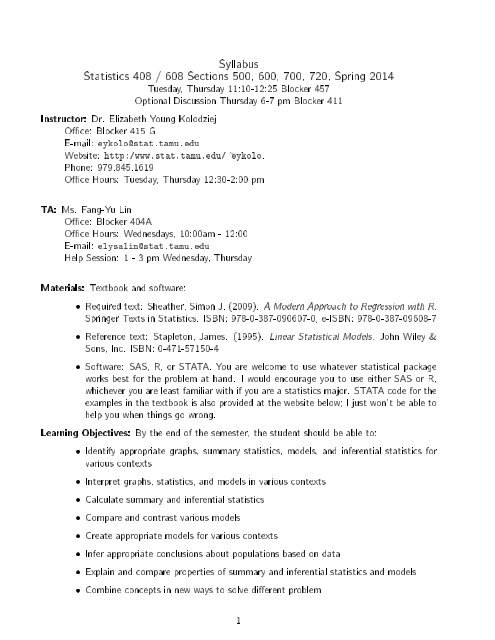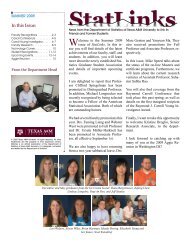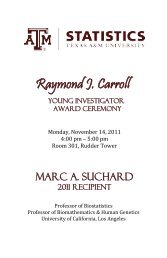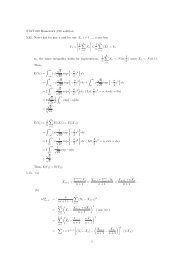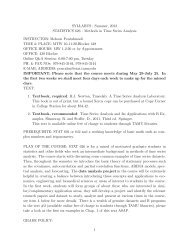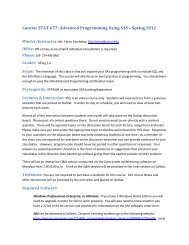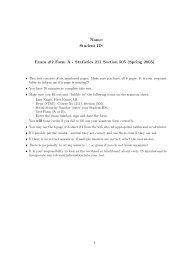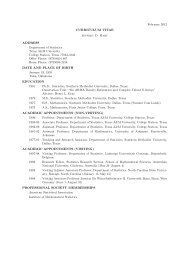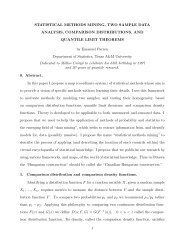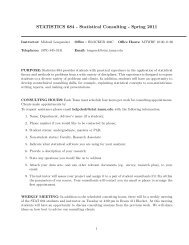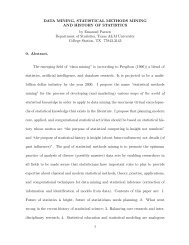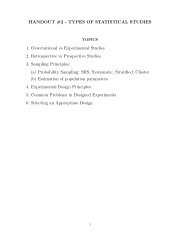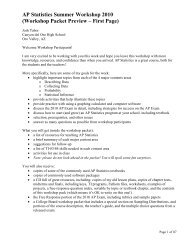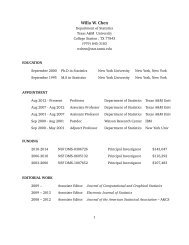SYllABUs Statistics 408 / 608, Spring 2013 - Texas A&M University
SYllABUs Statistics 408 / 608, Spring 2013 - Texas A&M University
SYllABUs Statistics 408 / 608, Spring 2013 - Texas A&M University
Create successful ePaper yourself
Turn your PDF publications into a flip-book with our unique Google optimized e-Paper software.
Syllabus<br />
<strong>Statistics</strong> <strong>408</strong> / <strong>608</strong> Sections 500, 600, 700, 720, <strong>Spring</strong> 2014<br />
Tuesday, Thursday 11:10-12:25 Blocker 457<br />
Optional Discussion Thursday 6-7 pm Blocker 411<br />
Instructor: Dr. Elizabeth Young Kolodziej<br />
Oce: Blocker 415 G<br />
E-mail: eykolo@stat.tamu.edu<br />
Website: http:/www.stat.tamu.edu/ ẽykolo.<br />
Phone: 979.845.1619<br />
Oce Hours: Tuesday, Thursday 12:30-2:00 pm<br />
TA: Ms. Fang-Yu Lin<br />
Oce: Blocker 404A<br />
Oce Hours: Wednesdays, 10:00am - 12:00<br />
E-mail: elysalin@stat.tamu.edu<br />
Help Session: 1 - 3 pm Wednesday, Thursday<br />
Materials: Textbook and software:<br />
Required text: Sheather, Simon J. (2009). A Modern Approach to Regression with R.<br />
<strong>Spring</strong>er Texts in <strong>Statistics</strong>. ISBN: 978-0-387-090607-0, e-ISBN: 978-0-387-09<strong>608</strong>-7<br />
Reference text: Stapleton, James. (1995). Linear Statistical Models. John Wiley &<br />
Sons, Inc. ISBN: 0-471-57150-4<br />
Software: SAS, R, or STATA. You are welcome to use whatever statistical package<br />
works best for the problem at hand. I would encourage you to use either SAS or R,<br />
whichever you are least familiar with if you are a statistics major. STATA code for the<br />
examples in the textbook is also provided at the website below; I just won't be able to<br />
help you when things go wrong.<br />
Learning Objectives: By the end of the semester, the student should be able to:<br />
Identify appropriate graphs, summary statistics, models, and inferential statistics for<br />
various contexts<br />
Interpret graphs, statistics, and models in various contexts<br />
Calculate summary and inferential statistics<br />
Compare and contrast various models<br />
Create appropriate models for various contexts<br />
Infer appropriate conclusions about populations based on data<br />
Explain and compare properties of summary and inferential statistics and models<br />
Combine concepts in new ways to solve dierent problem<br />
1
Important Websites: We will use the following websites throughout the course:<br />
A discussion board, grades, and notes will be posted here:<br />
https://dostat.tamu.edu/dostat<br />
Course Ref: ****, Registration code: ****<br />
SAS, STATA, and R code for the textbook examples can be found here:<br />
www.stat.tamu.edu/~sheather/book/<br />
Homework will be posted on Webassign:<br />
www.webassign.com<br />
See DoStat for login information.<br />
Prerequisite: Three semesters of calculus, linear algebra, some experience with programming,<br />
and a course in inferential statistics are prerequisites for this course. A basic understanding<br />
of Windows and MSWord and Excel will be helpful. Using our websites often requires the<br />
latest version of the internet browser Firefox, along with updated versions of Java and other<br />
such programs. You should know how to keep things updated on your computer.<br />
Topics: We will cover the following topics:<br />
1. Introduction to Design Matrices<br />
2. Simple Linear Regression<br />
3. Diagnostics and Transformations for Simple Linear Regression<br />
4. Weighted Least Squares<br />
5. Multiple Linear Regression<br />
6. Diagnostics and Transformations for Multiple Linear Regression<br />
7. Variable Selection<br />
8. Logistic Regression<br />
9. Serially Correlated Errors<br />
Exams: We will have two exams and a nal. Exam 1 is scheduled for Tuesday, February 18.<br />
Exam 2 is scheduled for Tuesday, April 1. The Final Exam is scheduled for Friday, May 2<br />
3-5pm.<br />
Grading: The grading scale is as follows:<br />
Homework 15%<br />
Exams 25% each - 2 exams<br />
Final Exam 35%<br />
You will NOT be allowed any extra credit projects to compensate for a poor average.<br />
Everyone must be given the same opportunity to do well in this class. The nal grade is<br />
based on a scale no stricter than 90-100: A, 80-89: B, 70-79: C 60-69: D, below 60: F.<br />
Incompletes: A temporary grade of I (Incomplete) at the end of the semester indicates that<br />
the student has completed the course with the exception of a major quiz, nal exam, OR<br />
minimal other work. The instructor shall give this grade only when the deciency is due to<br />
an authorized absence or other cause beyond the control of the student.<br />
2
Homework: Homework is required so that you get a better understanding of the material covered,<br />
plus it will help you to keep up. Each homework is worth the same percentage of<br />
your grade, regardless of the number of "points" it is worth. It is strongly encouraged that<br />
you work with another student. You will get a better understanding of the material if you<br />
discuss it with someone. You must submit your own work, however (see the section on<br />
Scholastic Dishonesty below).<br />
No late homework will be accepted, nor will you be allowed to make up missed homework.<br />
Solutions are posted immediately on the due date. To compensate for university<br />
excused absences, the lowest homework assignment score will be dropped. If you start the<br />
course late, it will be a missed homework. If your computer doesn't work or the system is<br />
down for the last 3 hours before it's due, it will be a missed or partial homework. If you<br />
have extenuating circumstances that require a dierent plan, please contact me.<br />
<strong>University</strong> Policies: Academic regulations and procedures are governed by <strong>University</strong> policy. Academic<br />
dishonesty cases will be handled in accordance the <strong>University</strong>'s policies.<br />
Aggie Honor System: An Aggie does not lie, cheat, steal, or tolerate those who do. Academic<br />
dishonesty includes the commission of any of the following acts: cheating, fabrication<br />
/ falscation, multiple submissions, plagiarism, complicity, and other types of misconduct.<br />
Upon accepting admission to <strong>Texas</strong> A&M <strong>University</strong>, a student immediately assumes a<br />
commitment to uphold the Honor Code, to accept responsibility for learning, and to follow<br />
the philosophy and rules of the Honor System. Students may be required to state their<br />
commitment on examinations, research papers, and other academic work. Ignorance of<br />
the rules does not exclude any member of the TAMU community from the requirements<br />
or the processes of the Honor System. Please see http://aggiehonor.tamu.edu for the<br />
complete Honor Council Rules and Procedures.<br />
Cheating is intentionally using or attempting to use unauthorized materials, information,<br />
notes, study aids or other devices or materials in any academic exercise. Unauthorized<br />
materials may include anything or anyone that gives a student assistance and<br />
has not been specically approved in advance by the instructor. During an examination,<br />
for example, looking at another students examination or having a conversation<br />
with others is cheating unless specically allowed in advance by the instructor.<br />
Fabrication is making up data or results, and recording or reporting them; or submitting<br />
fabricated documents. Falsication is manipulating research materials, equipment,<br />
or processes, or changing or omitting data or results such that the research is not<br />
accurately represented in the research record. The intentional invention and unauthorized<br />
alteration of any information or citation in any academic exercise; failing to<br />
acknowledge the actual source from which cited information was obtained; changing<br />
information on tests, quizzes, examinations, reports, or any other material that has<br />
been graded and resubmitting it as original for the purpose of improving the grade on<br />
that material are examples of fabrication and falsication.<br />
Complicity is intentionally or knowingly helping, or attempting to help, another to<br />
commit an act of academic dishonesty. Examples include knowingly allowing another<br />
3
to copy from ones paper during an examination or test; distributing test questions or<br />
substantive information about the test without the instructors permission; collaborating<br />
on academic work knowing that the collaboration will not be reported; taking an<br />
examination or test for another student; and conspiring or agreeing with one or more<br />
persons to commit, or attempt to commit, any act of scholastic dishonesty. For more<br />
information about <strong>University</strong> policies and regulations, please see the following:<br />
{ Academic Integrity and Student Rules: http://student-rules.tamu.edu<br />
{ Aggie Code of Conduct: http://compliance.tamu.edu/CodeConduct.aspx<br />
{ Aggie Core Values: http://www.tamu.edu/about/coreValues.html<br />
Statement on Disabilities: The Americans with Disabilities Act (ADA) is a federal anti-discrimination<br />
statute that provides comprehensive civil rights protection for persons with disabilities.<br />
Among other things, this legislation requires that all students with disabilities be guaranteed<br />
a learning environment that provides for reasonable accommodation of their disabilities.<br />
If you believe you have a disability requiring an accommodation, please contact<br />
Disability Services, in Cain Hall, Room B118, or call 845-1637. For additional information<br />
visit http://disability.tamu.edu.<br />
If you have a disability requiring an accommodation, please contact me as soon as possible<br />
so that we can make appropriate arrangements.<br />
4


